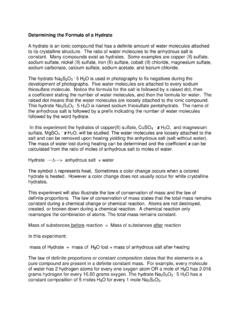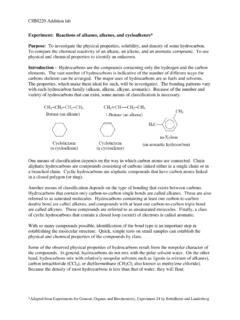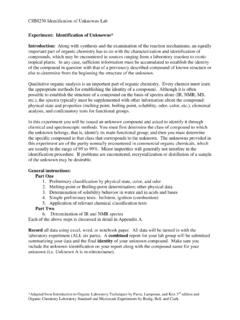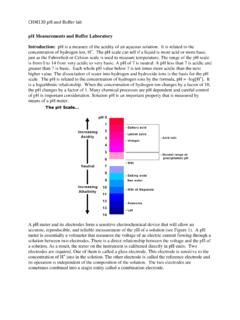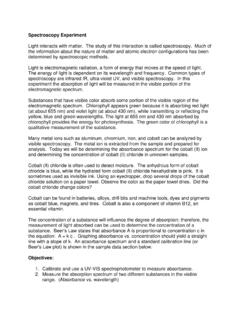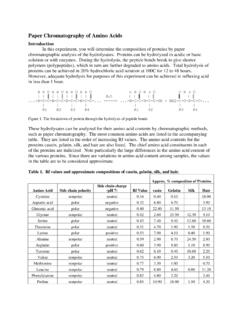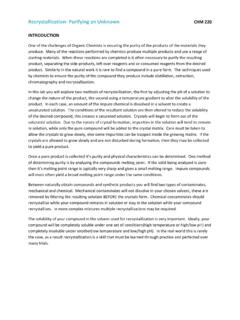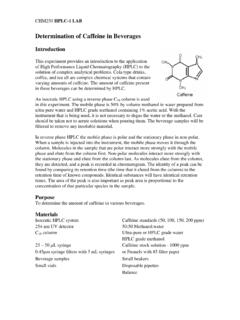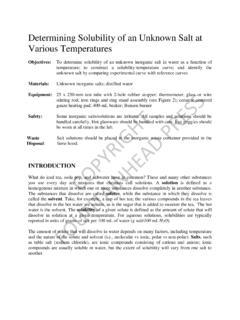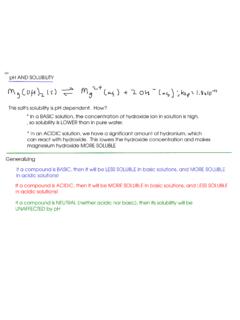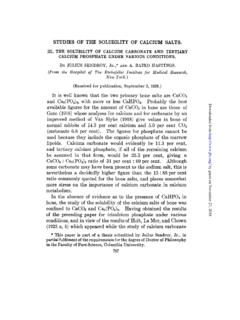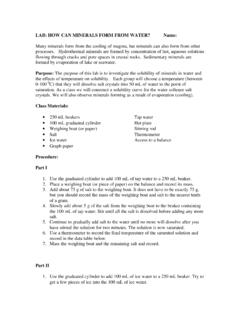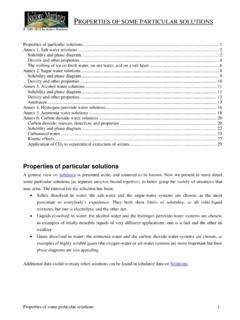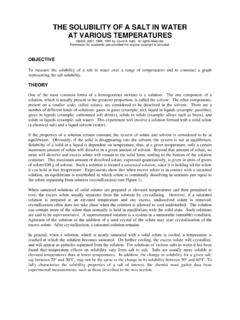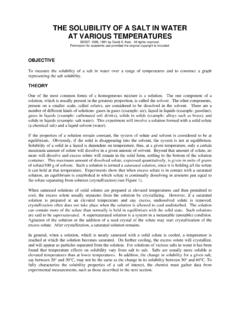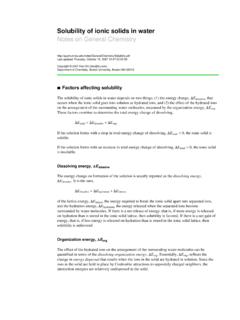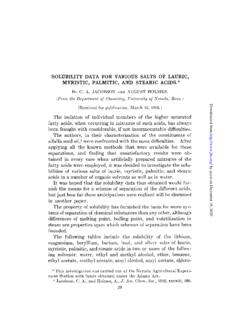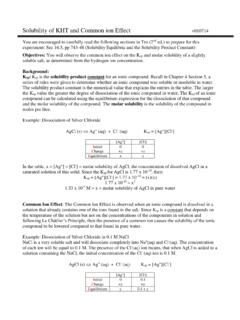Transcription of Experiment: Solubility Product Constant (Ksp) for a Salt ...
1 CHM130 Solubility Product experiment experiment : Solubility Product Constant (Ksp) for a salt of Limited Solubility Introduction: The equilibrium process in this experiment is a saturated aqueous solution of calcium iodate, Ca(IO3)2. The relevant Solubility equation and Solubility Product expression, are both shown below. Ca(IO3)2(s) <-=====-> Ca2+(aq) + 2IO3 (aq) Ksp = [Ca2+] [IO3 ]2 For a saturated solution of calcium iodate, if you can determine either the molar concentration of calcium ion, or the molar concentration iodate ion, the Solubility Product Constant can be found using the reverse of the process shown above. There was found the silver ion concentration, in a saturated aqueous solution, from a known value for Ksp. In other words, if the calcium ion concentration in today's experiment was found to be M, you could immediately say the concentration of iodate ion must be half that value, or M, according to the stoichiometry of the Solubility equation given above.
2 The Solubility Product Constant could then be found with simple arithmetic. In this experiment , the iodate ion concentration of a saturated calcium iodate solution will be found via a redox titration with sodium thiosulfate, Na2S2O3. The concentration of iodate ion (IO3-) will be determined by titration with a standardized sodium thiosulfate (Na2S2O3) solution in the presence of potassium iodide (KI). Starch will be used as an indicator, and a sharp blue-to-clear transition will mark the equivalence point. The relevant reaction equations are summarized as follows. IO3 (aq) + 5I (aq) + 6H3O (aq) --------> 3I2(aq) + 9H2O(l) This step, which occurs after adding both solid KI, and aqueous acid, to aliquots of saturated iodate solutions, has the net effect of converting iodate ions to aqueous iodine. Thiosulfate ion then reacts with aqueous iodine according to: I2(aq) + 2S2O32 (aq) --------> 2I (aq) + S4O62 (aq) The net titration reaction can be obtained by combining the two reactions above, then balancing for mass and charge: IO3 (aq) + 5I (aq) + 6H3O (aq) --------> 3I2(aq) + 9H2O(l) 3I2(aq) + 6S2O32 (aq) --------> 6I (aq) + 3S4O62 (aq) ---------------------------------------- ---------------------------------------- ----------------------------- IO3 (aq) + 6S2O32 (aq) + 6H3O (aq) --------> I (aq) + 3S4O62 (aq) + 9H2O(l) CHM It is important to notice the molar ratio of iodate ion to thiosulfate ion in the above complete, balanced titration reaction.
3 Aliquots from prepared, saturated solutions of calcium iodate in water, with and without additional calcium ion, will be titrated according to the reaction chemistry of the equations outlined above. Materials: 1. 2 - 250 ml beaker 2. 4 -150 ml or 250 ml Erlynmeyer flasks 3. 1 - ml pipet and pipet bulb 4. 1 - ml Buret 5. 2 - 10 ml graduated cylinder( 1 for solutions and 1 for KI solid) 6. Glass funnel 7. Stirring plate 8. Chemicals: Ca(IO3)2 , Calcium iodate Na2S2O3, sodium thiosulfate M KIO3 potassium iodate solution (for standardization only) solid potassium iodide M hydrochloric acid (Caution a strong acid) % starch solution Procedure: This exercise will contain four parts. Download the spreadsheet to record all of your data ( see Excel File) 1. Produce a Calcium iodate precipitate. 2. Standardize a Sodium thiosulfate solution by titration, using a M KIO3 solution to determine the concentration of the Sodium thiosulfate.
4 3. Use the standardized Sodium thiosulfate solution to determine the concentration of iodate in the saturated solution of Calcium iodate. 4. Calculate the Ksp of Calcium iodate. Experimental Notes It is important to handle the saturated iodate solution with great care, so as not to allow any of the solid calcium iodate into you titrations. This will obviously lead to a higher value for concentration of iodate than is actually present in the saturated solutions. Titrated solutions, and any left-over thiosulfate or iodate solutions, are safe to dilute and rinse down the sink. It is important for the Erlenmeyer flasks and other glassware you'll use to be as clean as possible when performing these redox titrations. Please take a moment to at least give them a thorough rinsing--they need not be completely dry before proceeding. Part 1. Saturated calcium iodate Ca(IO3)2 solution preparation: 1. Obtain gm of Ca(IO3)2 and transfer it into a 250 ml beaker.
5 Add between 100 and 175 ml of water to the beaker, record your volume of water added. 2. Place the solution on a stirring plate and mix for 30 minutes. Some of the white precipitate should remain visible. While you are waiting, proceed to Part 2. CHM 3. Filter the mixture using a Buchner funnel. The flask used to collect the filtrate should be as close to dry as possible. Do not pre-wet the filter paper. Filter the remaining precipitate and collect the filtrate. Do not rinse all the precipitate on to the filter paper. This will dilute your saturated solution. Discard the solids on the filter paper and any remaining in the beaker. 4. Keep this as your saturated solution of calcium iodate. Part 2. Standardizing the Na2S2O3 solution: 1. To prepare your solution, weigh approximately gram of sodium thiosulfate pentahydrate and record the mass. Transfer the sample into a ml volumetric flask. Fill half of the flask with water. Make sure all the solid has dissolved and then dilute to volume.
6 2. Obtain a 50 ml buret and rinse it with water to ensure it clean. Now rinse it with three ml portions of the Na2S2O3 solution that you just prepared. Fill the buret with Na2S2O3 solution. 3. Obtain two clean 150 or 250 ml Erlenmeyer flasks and pipet ml of M KIO3 into each of them. 4. Add 25 ml of water to each flask using a clean graduated cylinder. 5. Dissolve grams of KI solid into each flask. Add ml of 2 M HCl to each flask and swirl to mix. 6. Place the first flask on a piece of white paper under the buret and record the initial buret reading. 7. Now add ml of % starch solution. If any solution is on the side of the flask, rinse the wall of the flask with a stream of water. A color change should take place. Titrate the solution, by adding the Na2S2O3 a milliliter at a time until you see a color change. When the solution becomes very light in color, add the Na2S2O3 drop by drop until the solution becomes colorless. 8.
7 Record the final buret reading. Refill the buret and repeat steps 3 thru 7. If the volumes differ by more than ml repeat the process until two of the volumes of Na2S2O3 added differ by less than ml. Use these to calculate the molarity of the Na2S2O3. 9. If the 30 minutes have passed, start the filtration of the remaining calcium iodate from step one and continue the standardization. Part 3. Calculate the concentration of IO3- ion in the saturated solutions. 1. Rinse the Erlynmeyer flask used in the standardization with water. Invert them on paper towel until needed. 2. Complete Part 1 and use the saturated solution of Calcium iodate in the following steps. 3. Rinse a ml pipet with two ml portions of the saturated solution obtained and discard these portions. Pipet ml samples of the saturated solution into three Erlynmeyer flasks. To each flask add 25 ml of water, g of solid KI and ml of 2 M HCl, swirl to mix. 4. Place the flask on a piece of white paper under the filled buret (using the Na2S2O3 solution again).
8 Add ml of % starch solution. 5. Record the initial buret reading. Add Na2S2O3 in 1 ml increments until the solution becomes colorless. Record the final buret reading. 6. Refill the buret and repeat steps 3 thru 5. CHM Part 4. Calculations Standardization of Na2S2O3 solution. 1. Using the concentration and volume of KIO3 calculate the number of moles of KIO3. 2. Calculate the moles of Na2S2O3 needed in this titration and the concentration of Na2S2O3 for each trail. Average the molarities. Concentration of IO3- 1. Calculate the moles of IO3- based on the average molarity of the Na2S2O3 solution. 2. Calculate the molarity of the IO3- and Ca2+ in the saturated solutions. 3. Calculate the Ksp for each solution and an average Ksp.
